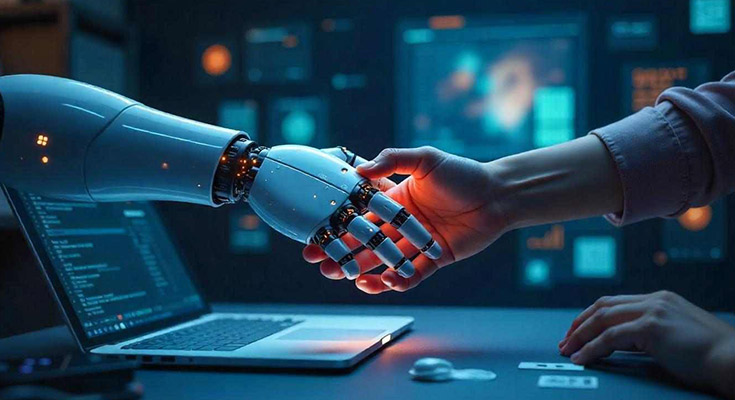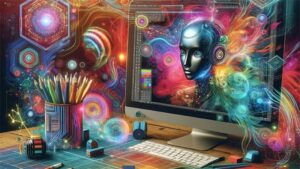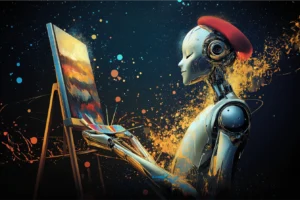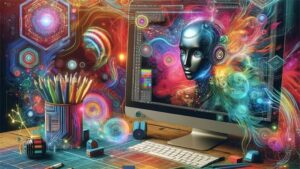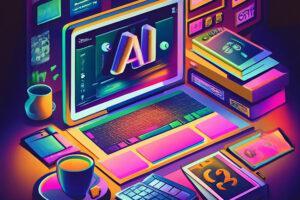In the ever-evolving landscape of technology, Artificial Intelligence (AI) is revolutionizing numerous fields, and the design industry is no exception. As digital creators, understanding how AI impacts design jobs is crucial to adapting and thriving in this new era. The integration of AI into design processes is reshaping roles, enhancing creativity, and streamlining workflows.
AI’s influence on design is evident in various aspects. From automating mundane tasks to offering creative suggestions, AI tools are rapidly becoming indispensable. As we delve into the transformative changes AI is bringing to design jobs, we will explore the implications for professionals and the opportunities it presents.

The Evolution of Design with AI
The design industry has witnessed significant transformations with the advent of AI. The integration of AI technologies has led to more efficient processes, enabling designers to focus on creativity and innovation. AI-powered tools assist in generating design ideas, predicting trends, and even creating complex visuals.
Automation and Efficiency
One of the most significant impacts of AI in design is automation. Repetitive tasks, such as resizing images or formatting documents, can now be automated, allowing designers to allocate more time to creative endeavors. According to a Creative Boom article, AI’s ability to handle routine tasks is freeing up designers to focus on more complex projects.
Enhancing Creativity
AI is not just about automation; it also enhances creativity. By analyzing vast amounts of data, AI can provide insights and suggestions that spark new design ideas. This synergy between human creativity and AI capabilities is opening new avenues for innovation.
AI’s Role in Different Design Fields
AI’s impact varies across different design fields, offering unique opportunities and challenges. Let’s explore how AI is influencing graphic design, architectural visualization, and 3D modeling.
Graphic Design
In graphic design, AI tools are aiding in creating stunning visuals with minimal effort. These tools can suggest color palettes, font combinations, and layout designs, helping designers achieve professional results quickly. For more insights, visit ManyPixels.
Architectural Visualization
AI is transforming architectural visualization by generating realistic renderings from basic sketches. This technology is accelerating the design process and allowing architects to experiment with various concepts efficiently. Learn more about this at AI for Architectural Visualization.
3D Modeling
In the realm of 3D modeling, AI is simplifying complex modeling tasks, making it accessible to a broader range of designers. Tools powered by AI can automatically generate 3D models from 2D images, streamlining workflows and expanding creative possibilities. Explore more at AI for 3D Modeling.
Opportunities for Designers
As AI becomes more integrated into design processes, the opportunities for designers are expanding. Embracing AI tools can lead to more efficient workflows, innovative creations, and a competitive edge in the industry.
Skill Enhancement
Designers who leverage AI tools can enhance their skill sets and stay relevant in a rapidly changing industry. By understanding how AI algorithms work, designers can create more sophisticated and data-driven designs.
Collaboration with AI
Instead of viewing AI as a replacement, designers can see it as a collaborator. AI can handle repetitive tasks, allowing designers to focus on the creative aspects of their projects. This partnership can lead to groundbreaking innovations and more satisfying work experiences.
Challenges and Considerations
While AI offers numerous advantages, it also presents challenges. Designers must be aware of these challenges to effectively navigate the changing landscape.
Data Privacy and Ethics
With AI relying heavily on data, concerns about data privacy and ethical use are paramount. Designers must ensure that their use of AI aligns with ethical standards and respects user privacy.
Over-reliance on AI
There’s a risk of becoming overly reliant on AI, which may stifle creativity. Designers should balance the use of AI tools with their creative instincts to maintain the integrity of their work.
The Future of Design Jobs
The future of design jobs is promising with AI as a powerful ally. As AI continues to evolve, designers will need to adapt and embrace new tools and techniques. The collaboration between human creativity and AI’s capabilities will lead to unprecedented innovations in design.
Emerging Roles
New roles are emerging within the design industry as AI becomes more prevalent. Positions such as AI design specialist and data-driven designer are becoming increasingly important, offering exciting career opportunities.
Continuous Learning
To stay competitive, designers must commit to continuous learning. Keeping up with AI advancements and understanding their implications for design is essential for professional growth.
Conclusion
AI is undeniably transforming the design industry. By understanding how AI impacts design jobs, digital creators can harness its potential to enhance their work and drive innovation. While challenges exist, the opportunities for growth and creativity are immense. As we move forward, the synergy between AI and human creativity will shape the future of design.

FAQ
How is AI changing design jobs?
AI is automating repetitive tasks, enhancing creativity, and offering new tools for innovation in design jobs.
What are the benefits of AI in design?
AI improves efficiency, enhances creativity, and provides data-driven insights, allowing designers to focus on innovative projects.
Are there any challenges with AI in design?
Yes, challenges include data privacy concerns, ethical considerations, and the risk of over-reliance on AI, which may affect creativity.

